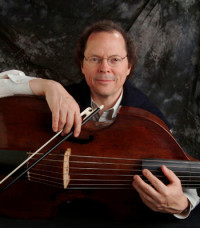by Jeremy Reynolds

“I had a friend in Chicago when we were both students,” Slowik said. “I found out that he had gone to BPI to study viol in the very first summer that it started, and he came back raving about the program. So much so that we did some playing together and crashed BPI the next year!”
The institute’s programming focuses on a different aspect of Baroque music each year. “I remember the theme was Italian music that year,” said Slowik, “but we brought a French duet for two bass viols. It was very well-received, despite the theme. I was very nervous at the thought of just showing up, but they just said ‘oh don’t worry, we’ll change the composer’s name from French to Italian.’ And that was that.
“I came back the next year for the full session, and went back to Chicago very enthused,” Slowik continued. “I bought an old Austrian instrument at an English auction an had it reconfigured to its original baroque form. I may have come one more year to BPI, and then a colleague of mine and the Caldwell’s — harpsichordist James Weaver, who was working at the Smithsonian — decided that he wanted to start a chamber group called the Smithsonian Chamber Players. So I joined the group, and, in the subsequent years at BPI, I taught as adjunct faculty until I became director in 1992.”
The theme this year is Circa 1690: prelude to a new century. (See Cathy Meints’s discussion of the theme here) How will this be reflected in the faculty concerts?
“The two faculty programs (Friday, June 26 and Friday, July 3) will center around 1690 with a variety of well-known and lesser-known works,” said Slowik. “We’ll open with two trio sonatas — Corelli’s Trio Sonata in D, Op. 3 no. 2 (1689) and Purcell’s Trio Sonata in C minor, (1683). Then flutists Michael Lynn and Christopher Krueger, will play a French sonata for two flutes and continuo. The French wrote for flute at a very low pitch: A=392. The rest of BPI will resolutely be at the traditional A=415. The evolution of French woodwind instruments in the last third of the 17th century paved the way for developments in the 18th century. So it’s nice to have this as an example of what came before.
“Then you’ll hear La Pucelle, an unedited sonata by Couperin, followed by another work by Marais — the Prelude and Chaconne in G for two bass viols and continuo (1686/89). Then we’ll switch gears again and turn to a sonata by Romanus Weichlein. After intermission you’ll hear Heinrich Biber’s Partita IV in Eb, a work for scordatura (retuned) violin and viola. Biber was well-known for his tendency to use these retuning tricks. After from Purcell’s Diocletian, Two Parts on a Ground for two recorders, Then Gonzalo Ruiz, our oboist, and Cynthia Roberts, our violinist, will play two Purcell sonatas rearranged for oboe and violin, one from 1683 and one from 1690. Finally, we’ll end the concert with Muffat’s Sonata in G Major (Armonico Tributo, 1682). He arranged it in 1701 for orchestra, and we’ll close with as many faculty members playing this arrangement as we can. It’s the ‘big band’ piece of our first recital.”
What about the second week’s program? “We’ve recently begun to include the student orchestra playing on the second faculty concert because we’ve discovered it’s the best place to showcase their work,” said Slowik. “We’ll begin with an overture that Corelli wrote for an oratorio on the life of Beatrice d’Este by his longtime colleague Giovanni Lulier.
“Then you’ll hear a Purcell trumpet sonata followed by a suite from The Fairy Queen, which has shrunken to just a suite because our baritone was forced to cancel due to health reasons. There will still be some dances coordinated by our dance instructor Julie Andrijeski, who will be working with her class on the program. Her assistant Elena Mullins will dance a solo number.
“After intermission you’ll hear be another trumpet sonata — this time by Corelli — then a serenade by Benedikt Anton Aufschnaiter. It’s actually a suite from his Concors Discordia (1695) in which he tries to bring the disparate elements of the French and Italian styles together. We’ll conclude with a suite from Lully’s Armide — there’s still surviving choreography for the passacaglia movement, and we’ll have a small chorus to fill out the ensemble.”
Since taking on his administrative role, does Slowik still work with students? “I still teach the cello class!” he said. And Slowik will give lectures throughout BPI to tie the master classes and performances together.
Published on ClevelandClassical.com June 22, 2015.
Click here for a printable copy of this article



